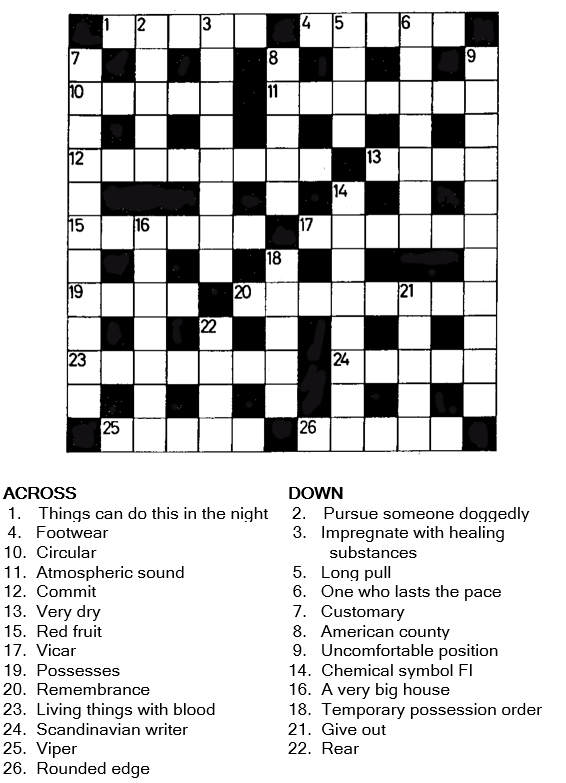
Edition 164 - October 2016

Lundy Through the dunes at Woolacombe
Illustration by: Paul Swailes
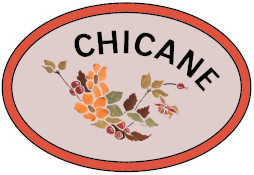
EDITORIAL
Summer is over and for us here, it really hasn't been a great one weather-wise. Extraordinarily, only 50 miles away, around Taunton, they've had quite a good one. It's no wonder we live in a green and lush part of the country! So, with winter approaching, don't forget to put the clocks back an hour on the 29th/30th October - at least we get an extra hour in bed!
The cover, Lundy through the dunes at Woolacombe, is the work of our Artist in Residence, Paul, one of his beautiful illustrations for the poem, At Woolacombe and Mortehoe, on page 10. Thank you, Paul, not only for the illustrations in this issue, but for the many hundreds over the last 26 years, since issue No. 7
Here again I must thank all the contributors although it would be lovely to have some new ones to support our great regular writers.
We seem to suffer a lot of changes in the residents of our village and we wish all newcomers good luck and happiness in your new homes. Judging from the number of properties on the market, we'll be saying some good-byes with our best wishes to you too.
Sadly, not everyone is feeling too good and the weather does nothing to help, but we hope you will all be feeling better and very soon.
If you are reading this on the first or second day of its circulation, do look at the article about butterflies for the Children's Hospice on page 31 and get your order in fast. Also, don't forget that Gary's book - an amusing account of life in Berry before the flowerpot men - is available from the Shop, Globe and Sawmills.
We are privileged to be having the Military Wives Choir here at St. Peter's - tickets are now on sale at the Shop.
Finally, Christmas cards are already on sale in the shops, but if you would like to send your greetings via the messages in the Newsletter, details can be found on page 45 and messages should be received by Wednesday 9th November, which is also the deadline for articles and items for the December and Christmas issue, the final one of 2016.
Judie - Ed
1

WEATHER
OR NOT
Well, the hoped for settled spell of
summer weather didn't materialise, July and August were both fairly mediocre
until near the end of August. Unfortunately, our weather station, which has
been providing all our information since 1994, had a malfunction of the rain
gauge at the beginning of July so we had to resort to more basic methods of
measuring the rain. After much research
we decided on a new weather centre which we are now trying to find our way
around. It will provide a lot more information than
the old one once we get the hang of it, although we haven't got a sunshine hour
recorder [an expensive extra] so will continue to rely on Chicane for the
sunshine.
Back to the weather. In July the jet stream was stuck too far
south which produced the unsettled conditions.
Rainfall amounts were fairly low
at 34mm for the month, but were spread throughout the month with most days having
showers or drizzle. Apart from a mini
heat wave on Monday 18th and Tuesday 19th when temperatures reached 27 DegC and
30.7 DegC respectively, temperatures were pretty average. The lowest temperature recorded was 9.9 DegC on
the 6th. Winds in the month were fairly
light with a maximum gust of 29 miles an hour which was also about average. Despite the unsettled conditions, 185.98
hours of sunshine were recorded, which was 17 hours more than last year.
The first day of August was very wet and
our new rain gauge recorded 44.8 mm of rain, this was followed by strong winds
and we recorded a maximum gust of 36 miles an hour on the 4th. The
weather then settled down with reasonable temperatures and low rainfall until
the weekend of the 20th when the Met. Office warned of a storm approaching. This unfortunately put paid to the Round Lundy
Yacht Race which Simon was hoping to take part in on a friend's yacht. The Saturday ended up with 16mm of rain and
wind speeds up to 40 miles an hour in the valley. According to information we received it was
gusting up to 50 miles an hour towards Lundy. That depression passed through and the weather
settled back down leading to a glorious bank holiday weekend for a change and a
very pleasant end to the month. The
total rain for the month was 88.8mm with a maximum temperature of 28.3 DegC on the
23rd. Last August we had 169.30 hours
of sunshine and this year we had
179.24, which was a bit above the average for the month.
The 1st of September is the
Meteorological start of autumn - where did that summer go?
Simon
and Sue
2
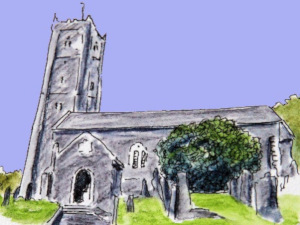
ST. PETER'S CHURCH
At last some good news! Our new Vicar, Rev. Michael Rogers, will be
installed in St. Peter's Church on Sunday, 23rd October at 11.00 a.m. The service, which will be a combined
service with Combe Martin, St. Philip and St. James and Berrynarbor, will be
led by our new Archdeacon Rev. Mark Butchers, and all are invited to this
special day. More good news follows
with the appointment of Bob Coles who will take on the role of House for Duty
Priest in support of Michael Rogers.
Bob will assist both Berrynarbor and Combe Martin parishes and his
special Licencing Service, supported by Michael Rogers, will be held at St.
Peter's Combe Martin on Monday, 5th December.
[NB An evening time has yet to
be finalised and we shall inform everyone as soon as possible.]
The Flower Festival entitled
Anniversaries 2016 was an outstanding success, with wonderful displays
commemorating The Royal Mail, William Shakespeare, Sir Isaac Newton, the first
commercial flight of Concorde and the first flight of the famous Spitfire. The artist L.S. Lowry was celebrated as was
England's famous 1966 World Cup victory, Roald Dahl and Beatrix Potter, and
Capability Brown. It was, of course,
the Queen's 90th Birthday, the 100th anniversary of the formation of Cubs and
Scouts, the 300th anniversary of the Great Fire of London and not forgetting
the 50th anniversary of the Ilfracombe Flower Club.
A big thank you to everyone involved in
the floral displays and to those who helped with the refreshments over the four
days of the Festival, and, of course, to all those who supported this
event. It is a pleasure to announce
that £464 was raised which will be apportioned to the Church and Ilfracombe
Floral Art Club, whose members' support was much appreciated.
We were hoping to hold a small fund
raising event in September, but this has been put on hold for the time
being. However, we are all preparing -
especially the Berrynarbor and School Choirs - for the forthcoming concert by
the Military Wives Choir on Friday, 4th November. There is much to do organisation-wise and we
hope to raise much needed funds for both the Manor Hall and the repair of the
church roof.
Sadly, two of our Choir members - Linda
Lunn and Elain Filer - are going through difficult times with Linda losing her
husband recently and Elaine's brother very poorly in a hospice. Our thoughts and prayers are with them both
and their respective families.
Please note that the Sunday Services
for October will be slightly different and are as follows:
- Sunday, 16th October Songs of Praise, 11.00 a.m.
- Sunday, 23rd October Installation of Michael Rogers, 11.00 a.m.
- Sunday, 30th October Joint Service with Combe Martin, 11.00 a.m. [a non-Communion service]
- Sunday, 13th November Remembrance Sunday, 10.30 for a 10.45 a.m. start
Friendship Lunches will be held in The
Globe as usual, 12.00 noon for 12.30 p.m. on the last Wednesday of the month -
26th October and 30th November.
Stuart Neale

This picture of St. Peter's was taken
some 50 years ago and shows elm trees on the left hand side of the lychgate. Sadly, they died. One fell down the other was cut down by Ivan
Huxtable, Bill's twin brother. He was
the only person with a chain saw!
Lorna Bowden
Was this a case of Dutch Elm Disease? Dutch elm disease is caused by a member of the sac fungi and is spread by the elm bark beetle. Although believed to be originally native to Asia, the disease has been accidentally introduced into America and Europe, where it devastated native populations of elms that did not have resistance to the disease. About 1967, a new, far more virulent strain arrived in Britain on a shipment of rock elm logs from North America, and this strain proved both highly contagious and lethal to European elms; more than 25 million trees died in the UK alone. By 1990 very few mature elms were left in Britain or much of continental Europe.
One of the most distinctive English countryside trees, the English elm is particularly susceptible. Thirty years after the outbreak of the epidemic, nearly all these trees, which often grew to more than 45m high, were gone. The species still survives in hedgerows, as the roots are not killed and send up root sprouts or suckers. These suckers rarely reach more than 5m tall before succumbing to a new attack of the fungus. However, established hedges kept low by clipping have remained.
3

BERRYNARBOR HORTICULTURAL & CRAFT SHOW 2016
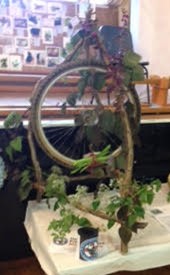
Thank you
to everyone who entered, supported and helped on this year's Show. A new committee is required to carry this
event on, so please come forward and volunteer or the Show could end!
In the
afternoon there was a good turnout which was great, and we raised just under
£160.00 after costs, so a big Thank You.
The
organising group would like to congratulate all the winners. The awards for this year were:
- Floral Art - The Globe Cup - Lyn Wheelan
- Home Cooking - The Walls Cup - Sue Owen
- Handicrafts - The Davis Cup - Chris Jesson
- Handicrafts - The Watermouth Cup- Tony Summers
- Grow Your Own [Potatoes] - Kim Beaver
- The Largest Sunflower - Sloley Farm
- Art - The George Hippisley Cup - Judie Weedon
- Photography - The Vi Kingdom Award - Jim Constantine
- Fruit & Vegetables - The Derrick Kingdom Cup - Tony Summers
- Potted Plants - The Lethaby Cup - Sloley Farm
- Cut Flowers - The Manor Stores Rose Bowl- Barbara Eales
- The Manor Hall Cup for Best Horticultural Exhibit- Barbara Eales
- The Ray Ludlow Award for Best Non-Horticultural Exhibit - Tony Summers
- The Watermouth Castle Cup for Best Exhibit on Theme of Show- Sloley Farm
- Overall Children's Winner Rose Bowl - Roxanne Barrow
Children's Cumulative Totals:
- Under 5 years
- 1st Roxanne Barrow - 28 points
- 2nd Emily Stanbury - 14 points
- 3rd Poppy Townsend -13 points
- 6- 9 Years
- Joint 1st Ruby Barrow and Salah Gingell - 21 points
- 3rd May Townsend - 7 points
-
- 10-13 Years 1st Witold Zajac - 6 points
The
Charity Wheels raised £52 for Devon Freewheelers. Well done to those who entered and helped
raise this donation.
Hall Centenary Artwork [1914-2014]
'The Show
Judges would like to especially commend the Hall Collage. Wonderful skills and example of bringing the
community together!'
On behalf
of everyone who entered the Show and those who came along in the afternoon to
see the exhibits, a big thank you to the organising group, especially Karen for
all her hard work.
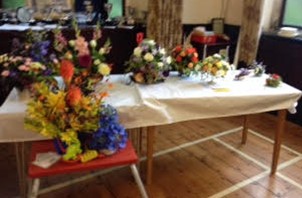

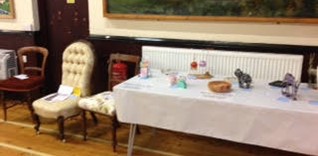
;
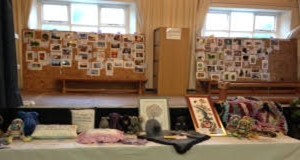
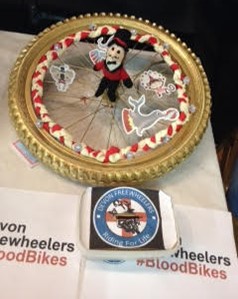
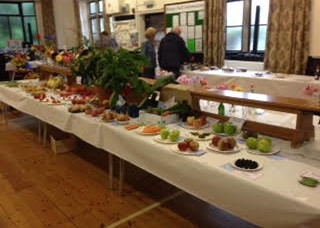
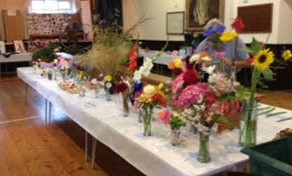
Photos by: Karen Loftus
4
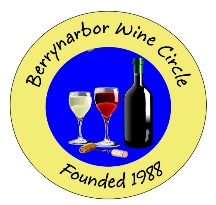
BERRYNARBOR WINE CIRCLE
'Wine
makes daily living easier, less hurried, with fewer tensions and more
tolerance.'
Benjamin
Franklin
Unusually, our seasonal programme isn't
finalised yet; however, I can tell you
that we begin on Wednesday, 19th October, with Peter Rollinson of Bray Valley
Wines, South Molton. Bray Valley began in 2002 with Charlie Cotton
recognising that only the supermarkets could provide his daily drinking
wines. Their wines, 80-100 types, are shipped in and
known to him as they have all been tasted at some point. Peter jumped at the opportunity to join the
business in 2005. When I mentioned 'livers', he replied, "I
probably don't have one!"
November is 'up for grabs', but
December, is our pre-Christmas event and will be our usual Committee's Choice. Wednesday, 14th January 2017, our first meeting
of another new year, is on the 18th and will be our ever-popular Call My Wine
Bluff. One of our members said that she wished we
could do this every month! I know it takes hours of preparation by Tony
Summers, our Chairman, so I know it won't happen, but we like to provide a
varied programme too.
Our season begins in October and runs
until May. Tastings are always the third Wednesday of
every month, apart from December's, which is the second Wednesday. The
monthly fee, per person, has been £6 since 2008; this covers the bills for our food and drink
and Hall fees. As we all know, all
prices rise; so, as from October,
per-person fees will be a very reasonable £7.
We don't charge for conviviality! Our
monthly tastings are a great way to meet others from the village who may not be
your neighbours. We look forward to seeing new faces; the Hall has plenty of space, but our
enjoyment often fills it!
Judith
Adam - Secretary and Programme Co-ordinator
5
NEWS FROM OUR COMMUNITY SHOP & POST OFFICE
New Information Point
After a year of waiting, the 'phone box from Berry Down has finally arrived at the shop.
The intention is to turn it into an information point, a relevant use of a de-commissioned 'phone box, with maps, leaflets and general local information; it will help walkers with extra information, provide information on local events and services and at the same time assist visitors and delivery drivers in finding the house they are looking for.
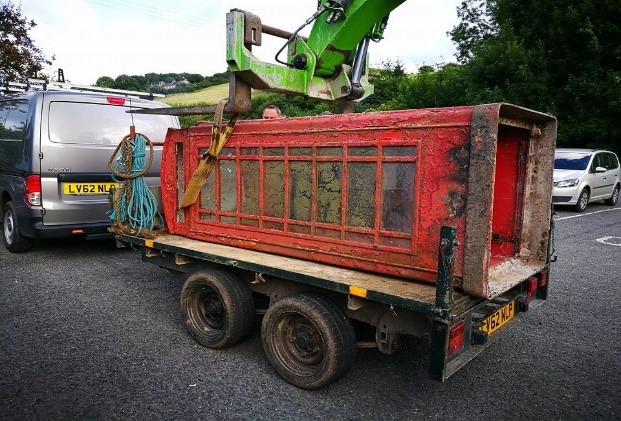
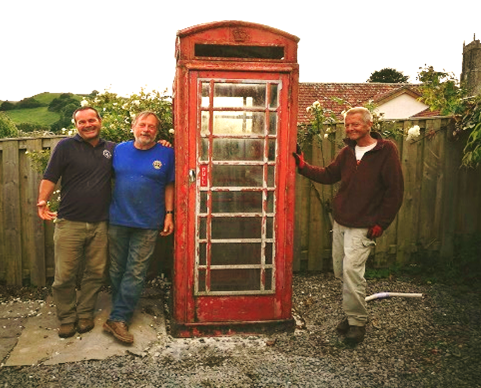
Many thanks to Alan, Richard and Keith for their hard work on the day bringing it to its new home and Alan for giving up so much time to dig it out. Thanks also to Stowford Meadows for the telehandler.
The 'phone box joins the new benches which eventually will provide a seating area, refreshments and access to maps and information leaflets of attractions in our area, thus providing a valuable and hopefully attractive addition to the services offered by the Community Shop.
Now we need to refurbish the 'phone box! As you can imagine, it will require a good few hours of work, so, if you have a bit of time to spare we should be very, very grateful for you to come and help us restore it to its former glory! Please let Debbie or Karen know if you would like to join a work party to help us achieve our mission - coffee, tea and biscuits on offer!
6
AT WOOLACOMBE AND MORTEHOE
Across the grass, along the shore, the waves are crashing, constant roar.
Best foot forward, brace to the wind, "Hold on to your hat," I said, and grinned.
The sea is grey, and green, and blue, a marv'llous ever-changing hue,
A soaring gull wings by on high, and now we hear its plaintive cry.
The tide flows in, and ebbs away, and headlands guard and end the bay.
On rocky Morte the waves crash down, at Baggy Point, a green dome crown.
Against the blue, the white clouds race, so smoothly by, with stately grace.
The air is fresh, and clean, and clear, just breathing fills one with good cheer.
Amid the bay, far out to sea stands Lundy Island, wild, and free.
Behind the dunes, on Potters Hill, the view of Lundy's better still.
When reaching rock at Putsborough end, we turn around and footsteps bend
To Combesgate back along the bay with Mortehoe high above the spray.

Whilst walking back along the shore, I dream of days I came before.
The first time I was just a lad on holiday with Mum and Dad.
My sister also, friends as well, we all fell under quite a spell.
We surfed, and shrimped, and swam in pools, and climbed the rocks, and dug with tools.
We built up castles, high and wide until the sea swept them aside,
And dammed up streams, and floated boats, and girt our castles round with moats.
We're coming here again quite soon, we came here on our honeymoon,
And later when the children grew, we brought them here with grannie too.
We wanted them to join the fun, and feel the spray, and wind, and sun;
To dig, and surf, and climb, and run, and love this place as we have done.
When sometimes visibility is marred, a raging westerly blows hard,
And rollers lined across the bay surge forward firmly through the day.


The sea is boiling down below, a restless, swirling, foaming flow.
We watch for hours the giant knocks administered to jagged rocks.
The shooting spray is splashing high without a care as time goes by.
The wind now seems a little cold, a sign, perhaps, we're getting old.
A grandchild first, and now there're two, have been indoctrinated too
With qualities which stand, and last from very different long time past.
With health, and fitness, and good fun, succeeding generations run.
As years and centuries roll away there's little change across the bay.
Tomorrow we will walk to Lee, along the paths above the sea,
'cross field, and hill, and down the lane the pleasant vistas never wane.
The village lies between the hills, it's warm, and low, and often fills
With scent of flowers mingled sweet, afloat upon the summer's heat.
This place of great tranquillity Is great to visit, and for tea,
But cut off from the world without, then, once I'm in, I would be out.
Back at Woolacombe, the bay then welcomes me return to stay,
And watch the sunset fill the sky with beauty, colour, climbing high.
I come from Hampshire, roots in chalk, and there I also love to walk.
My heart is there, but likes to roam, and Woolacombe's its second home.
When strolling on the golden strand, or somewhere else, but near at hand
I hope that you can share with me the peace and joy, be happy, free.
Unknown - 1998

Illustrations: Paul Swailes
7
ERRATA

Having
met up with Nipper [Gerald] Bray in The Globe, he tells me that there were some
errors in the photographs appearing in the August Newsletter!
The
first is in the picture of a Dance at the Manor Hall and he says the lad in the middle at the front is not
Alistair but Dave Chalmers.
Regarding the picture said to be taken outside the Sawmill Cafe following Tom's article on the Sawmill Inn was, in fact, taken by Nipper, and it was in front of the log cabin [cafe] at Watermouth Caves, now Watermouth Cove.
It shows. from left to right, Theodore Chalmers, 'Psychie' Sanders
[chef], Chris Huxtable, John Valance and Malcolm Chalmers.
He says he believes that the young man by the signpost might be Robin Kift from Langleigh House.
Ed


8
INFORMATION PLEASE
Does anyone remember anything about two sisters, Helen and Marguerite de Munck, who lived in Birdswell Lane? Helene died more than 50 years ago, 1964, Marguerite in 1987. They were born in Belgium and for a while ran a B & B at The Old Court.
If anybody feels that they can help, or even supply a photograph of these sisters, I should be delighted to receive this to forward to another author, writing a soon-to-be published book on a contact of Helene.
Please contact me on geoffrey.judith@gmail.com.
Judith Adam
9
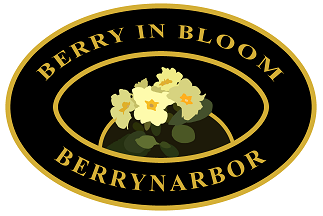
BERRY IN BLOOM & BEST KEPT VILLAGE
The judging for both competitions has
taken place and we await the news of how we have done. I think the village has looked lovely this
summer and hopefully the judges have agreed.
I know that the team couldn't have worked harder. We get the results at the beginning of
October.
We shall be taking out the tired summer
bedding and planting the spring bulbs in late September and early October.
The
village Open Gardens afternoon in August was successful and we made over £300
to go towards spring bulbs etc. but as the weather was lovely that afternoon we
had hoped for a few more people. Maybe
the holiday makers were all headed for the beach on that day. Many
thanks to everybody who supported us in whatever way, especially all those who
worked so hard to open their gardens, and Phil and Lynn for hosting the teas in
their lovely garden at the Lodge.
If anyone is interested in helping our
team we should welcome you with open arms, just contact me on 01271 883170.
With the money donated at her funeral,
in remembrance of Edna Barber we have now purchased a ceramic planter. It is placed near the remembrance cross in
the churchyard, planted with a rosemary surrounded by violas and under planted
with bulbs to flower in the spring.
Wendy Applegate
10

Butternut
Squash and Ginger Squares
This is a lovely moist cake with a warm
autumn taste and freezes well. Makes 1 x
23cm [9inch] tray bake.
- 175ml [6floz] any light oil such as vegetable or groundnut oil
- 225g [8oz] golden caster sugar
- 3 free range eggs separated
- 3 tablespoons whole milk
- 125g [4.5oz] coarsely grated raw butternut squash
- 1 tablespoon finely grated fresh ginger
- 75g [3oz] walnuts finely chopped
- 75g [3oz] raisins
- 175g [6oz] plain flour
- 1.5 tsp baking powder
- 3/4 tsp ground ginger
- 3/4 tsp cinnamon
To
Finish:
About
3 tablespoons stem ginger syrup from a jar plus 2-3 knobs of stem ginger finely
sliced
Preheat the oven to 190C/170C fan/gas 5
and butter and line a 23cm [9inch] non-stick square cake tin or equivalent such
as a brownie tin.
Whisk together the oil and caster sugar
in a large bowl to combine, then whisk in the egg yolks and milk. Fold in the butternut squash, grated ginger,
walnuts and raisins.
Sift the flour, baking powder and spices
together and fold into the mixture.
Whisk the egg whites in another bowl
until stiff using an electric whisk and then fold them in two batches in to the
cake mixture.
Transfer this mixture to the prepared
tin and smooth the surface. Bake for
35-40 minutes or until shrinking slightly around the edges and a skewer
inserted comes out clean. It is
essential not to open the oven door before this time.
Once removed run a knife around the edge
of the cake and drizzle over the ginger syrup, evenly coating the surface with
the back of a spoon, decorate with the sliced ginger in syrup.
Cover with cling film and set aside to
cool before cutting into squares.
The
recipe says that these keep well for several days in a tin, but in my house
they disappear in a moment, I hope you enjoy them.
Wendy
11
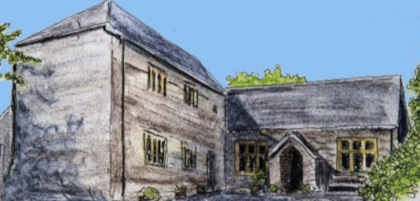
MANOR HALL TRUST
NEW
BOOKING CONDITIONS
In August we advised that a new
returnable breakages deposit was being expanded to cover the issue of rubbish
being left behind, as often seems to happen after a large event. We have had incidents with food waste,
bottles, drinks cans and large quantities of cardboard being left behind and we
have no facilities for this kind of waste disposal. In
future, for larger events, mostly but not exclusively parties and weddings, the
breakages deposit will be £50, payable in advance. For
children's parties it will be £15.
These deposits will not be refunded if the
hall is left in a mess and/or rubbish is left behind.
Remember these changes will not affect
regular users with their week by week events, although the new terms will apply
if a regular user wishes to hold a one-off event.
CHRISTMAS
CARD EXCHANGE
Like last year, we shall not be holding a Christmas card
exchange service this December given a decline in the use of it in recent
years. We are sorry if this causes any inconvenience.
Some
people may wish to place season's greetings in the village newsletter instead.
MILITARY
WIVES CHOIR EVENT 4TH NOVEMBER
We look forward to the special event
being held in the church on Friday, 4th November - it may be that this is sold
out by the time this newsletter goes to print, but if not then please remember
that it is a joint fund raiser for the Church and the Manor Hall. Tickets on sale at the Shop. Many thanks to Judith Adam and Stuart Neale
for their work in organising this event.
WORK TO
THE HALL - MANOR HOUSE WING
As stated in the August Newsletter, the
work to implement our structural engineer's recommendations to repair and
stabilise the old [medieval] roof above the Men's Institute is now out to
tender. At present we can't say exactly
when this work will start on site but it should take place this coming winter. In order to comply with the planning
permission obtained, we have had to agree a very detailed archaeological Written
Scheme of Investigation for this work with North Devon Council. We can say, however, that the proposed work
will accord with SPAB principles [Society for the Protection of Ancient
Buildings], that is to be non-destructive.
NEW
CONSTITUTION FOR THE MANOR HALL TRUST
In the June Newsletter, we summarised
the proposal to convert the Manor Hall Trust into a new type of charity knwn as
a Charitable Incorporated Organisation or CIO. This topic has been the subject of public
discussion back in June, and we are pleased to say our new CIO is now registered
as a charity with the Charity Commission, Charity No.1169090. As
advised previously, in the new CIO constitution we have also replicated the
existing practices for appointing Hall Committee Members - that is electing
some committee members at the AGM, with others being nominated by key user
groups, in the same way as first established in the original 1947 conveyance of
the Hall. The nominating organisations
are the same, that is the Parish Council, the Primary School, Berrynarbor
Pre-School, the Men's Institute and the Parochial Church Council. However, to start with, the CIO will operate
with the existing Trustees, i.e. the current committee members.
As the new CIO will effectively merge
with the current charity, it will keep the same name, the Manor Hall Trust. We now need to complete the necessary legal
documentation with the Parish Council.
Manor
Hall Management Committee
13
QUICK QUOTE
On free speech
"Having the right to say something is not the same as its being right to say it."
G.K. Chesterton
[1874-1936]
14
THE ANDREW NEALE TROPHY
Our son Andrew was a very fine
sportsman and excelled in many disciplines, including swimming, athletics,
mountain bike racing and mountaineering.
In January 1991, aged just 16, he
contracted salmonella and his condition deteriorated so badly an ambulance was
called and [as we found out later] he sadly died in the ambulance as it was
passing Ilfracombe Swimming Club on the way to the North Devon Hospital.
A special trophy was requested by
Ilfracombe College [as it was then] in memory of Andrew's achievements which is
presented annually to any pupil who has achieved sporting excellence and
sportsmanship throughout the year.
A few days ago, June Marangone
mentioned to me in passing that a boy from Berrynarbor had won Andrew's Trophy,
and I am delighted and proud that this special award has really come home to Berrynarbor!
This year's winner is Finley Ball who
has and continues to achieve sporting excellence in a wide range of disciplines
- swimming, athletics and football. He
is a member of the Surf Life Saving team at Woolacombe and a member of
Ilfracombe Football Club. However, it
is cross-country running in which he really excels winning both the North Devon
Cross Country League and North Devon Schools competitions. As a result of these achievement he was
selected to run for Devon in the English
Schools Cross Country event. Finley
also ran in the London Mini Marathon coming a respectable 29th - well up in the
field!


Finley is very proud to have won
Andrew's trophy, especially in view of Andrew's sporting achievements at County
and National level. The photographs
show Andrew sitting on top of the second highest mountain in the
Pyrenees, having climbed it with a group of other students who formed he North
Devon Pyrenees Expedition in 1990, and
Finley holding the Andrew Neale Trophy.
Stuart Neale
15
FORAGING
Recently I was reading a smallholding
magazine and this article regarding profit from hedgerows, caught my eye. It suggested planting a few damsons instead
of blackthorn and Kentish cobnuts or filberts instead of the common hazel as
both of these would be beneficial to wildlife, and could be a small cash crop
at any farmers' market, without using any paddock space or pasture.
This made me remember our Sunday family
walks in the '50's around the lanes, fields and woods of Berrynarbor. Someone would always carry a bowl or bag to
bring home our foraged gatherings. On
one occasion we picked a whole pudding basin full of wild strawberries on the
road to Berrydown, not far from where we lived. On arriving home these were soon "polished
off" with the cream from the top of scolded milk from Barton Farm and, of course,
a sprinkle of sugar! I am sure this is
when my love of foraging began!
My grandmother was a very resourceful
woman, she could still put some form of greens on a dinner plate even after all
the winter cabbage and collards had finished.
Collards being spring green type growths that come from the cross split
stumps left in the ground. but before the summer cabbage was ready.
She would, on rare occasions, armed only
with an old motorbike gauntlet, pick young nettle tops down the lane! These are similar to spinach, but stronger
and darker. These were quickly boiled
and strained, salt and pepper added, finished off with a knob of butter and
gran's favourite spice, a hint of nutmeg, which she could produce from her
pinny pocket quicker than Roy Rogers could draw his six shooter!
Gran
also introduced us to small young dandelion leaves. I personally thought they were a little
bitter, but in a salad sandwich with salad cream etc. they were quite good!
On visiting Normandy a few years ago.
there, in a supermarket, were pale forced dandelion leaves 2.80 euros a bunch!

Blackberries
[Bramble]
Almost everyone has picked and eaten
these berries. The small red and part
ripe ones can be made into good wine,
while the plump, larger berries can be used in many ways. Try blackberry liquor using a similar recipe
for sloe gin, but with a little less sugar.
Freeze the required amount of berries before adding to gin or vodka in a
Kilner jar, gently agitate weekly for the first month, then forget them for the
next three or more, then carefully strain and decant.
Folklore tells us that after Michaelmas Day
the Devil has spoiled the berries and his little helpers have put maggots in
them just for fun!
Hazel and sweet chestnuts thrive in
Berrynarbor. We kids used to play and
collect hazelnuts from a wooded goyle known as Sherry-Brockholes, not far from
Ruggaton Farm. Sweet chestnuts seemed
to favour Sterridge Valley from Woolscott Cleave right down to the Old Rectory.
Collect both nuts when they are brown
and ready to come free from their husks.
Chestnuts are best rolled under foot to remove them from their spiny
husks. Store them both in old onion
sacks, hung from a beam in a cool and airy place.
In medieval times, before the potato had
arrived, chestnuts were used very much in the staple diet, even ground and
added to bread flour.
Mushrooms
and Fungi
The golden rule with these is, if you
cannot identify them, do not pick or eat them, therefore the three I have
chosen to mention can be found in supermarkets when in season. The field mushroom is the same species that
you see in the supermarket, but has much more flavour. They prefer a sloping field that faces south,
near the top or ridge, especially if stock has been present in the last few
years. Cropping season is August to
October.
Oyster mushroom clumps can be found on
dying deciduous tree trunks in woodland. The top cap can be a little darker
than the supermarket variety. It is generally safe to say that any fungi
growing from a tree trunk above chest high are safe to eat, although some can
be tough and unpalatable.
The chantarelle or girolles are a
wonderful, medium sized funnel shaped mushroom, completely egg yolk yellow and
a joy to find and eat! They can be found growing through the moss at the base
of beech hedges and trees in dappled light. Cropping season is May to November.
They
need to be gently fried in garlic butter with salt and pepper then add some
milk and simmer until it reduces.
It is said that even the grumpiest
French chef will smile when he sees chantarelles!
Enjoy!
Ray Thorne

Illustrated by: Paul Swailes
16
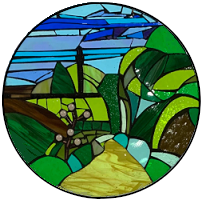
RURAL
REFLECTIONS 76
One aspect of my job role in supporting
adults with mental health problems is to receive telephone calls on my
allocated duty days. The enquiries vary enormously. It may be a patient
requesting an earlier appointment with their care co-ordinator or a third party
expressing concern about someone they have just visited. Some calls. on the other hand, are from
people in crisis which, more often than not, have resulted from an occurrence
that triggered their sadness, anxiety or anger to spiral out of control. In some cases, these uncontrollable feelings
can lead to a desire to carry out a harmful reaction either to their
environment, to other people or to themselves.
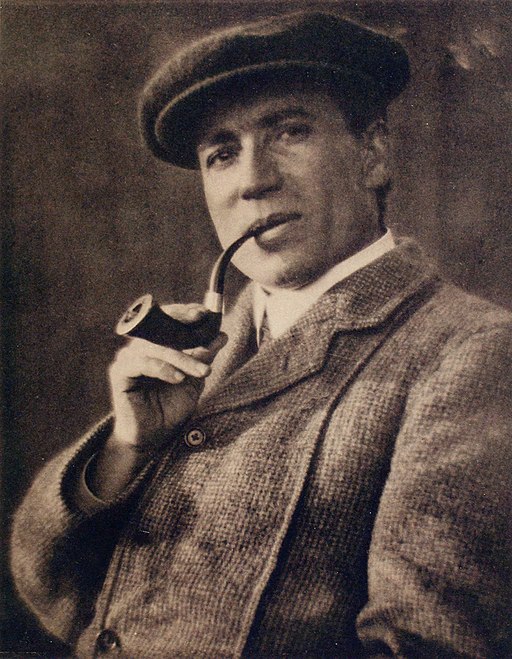
William Henry Davies
Coburn, Alvin Langdon, 1882-1966 -- Photographer
Public domain, via Wikimedia Commons
Before I go any further, I must emphasis my greatest respect
for skilled workers, both in an employed and voluntary capacity, who receive
such calls without any prior knowledge of the person on the other end of the
line. For even if I have not dealt with
them personally, they will at least be known to our service. This allows me the luxury to bring up their
details on my computer screen and, when they are in crisis, refer to their
coping strategies. These strategies are
fluid and regarded as work in progress, the person developing in time more effective
ways of coping. Interestingly, a new technique is being introduced and is one
that many of our patients are finding beneficial.
It is a form of therapy about which even
I as a professional was at first sceptical -
just a previous therapy regurgitated in a modern format; another gimmick
from America; an opportunity for someone
to make a few bucks selling their books, CDs and DVDs. Of this latter point I felt I even had proof,
two friends having bought CDs and finding them ineffective. Mindfulness, huh . . . just wait until I speak
to that mental health OT who runs the group.
So I did. She said that ideally people should not be
left to their own devices; for it to be
effective, people need guidance and support.
But what of my other points? In
response, she said there was scientific evidence, that it was based upon
Buddhist teachings from two thousand years ago and that it had comparisons with
the various principles and practices of all religions. Hmm . . .
Stripping away all its layers it seems
that Mindfulness, in its simplest form, is about living in the present moment -
a point highlighted in my previous article about all the appointments and
schedules that seem to dictate our modern lifestyle. That's not to say, of course, that we can
stop the march of time. But do we have
to live by the clock? For as William
Henry Davies wrote in his poem, Leisure. 'What is this life if, full of care,
we have no time to stop and stare.'
It is his last three words that are the
key. After all, it is one thing strolling
through an autumnal woodland admiring the various shades of gold. but it is
another to make a conscious effort to stop in your tracks and not
only stare but also to listen intently and to inhale the aromas; to study the view furthest away from you, the
area close at hand and the detail above and below you. Of all these directions, looking downwards
can feel the most unnatural. Yet you
will be surprised what there is to see, especially at this time of year when
the woodland floor is resplendent in fungal colours and shapes. But it can also be beneficial to look at the
ground surrounding your feet, for you will discover autumn leaves all at their
unique stages of decomposition. Only
this morning, whilst walking our three Labradors through Weston Woods, I
glimpsed a sycamore leaf on the path undergoing its annual decay. Having picked it up, I brought it home and
examined it whilst supping my milky coffee.
Yes, I know it seems a bizarre thing to do. Yet the more I studied the leaf, the more
beautiful it became.

Typically palmate in shape and having
five pointed lobes, this particular leaf was roughly the size of a young
teenager's hand, slightly outstretched.
The main lobe, pointing directly at twelve o'clock, was around three inches
in width across the centre with the other four lobes decreasing at various
rates with the lobe pointing southwest, have a width of just over an inch. The
outline of the leaf displayed two distinct edging patterns, one having a jagged
edge the other an irregular, ripped appearance. From its base, five veins curved upwards and
then through the centre of their allotted lobe. Some lobes had further veins
that were quite distinct, leading off alternately from the central vein. Mustard yellow dominated the leaf, covering
most of the top lobe and its right hand neighbour. A coffee cream shade followed the contours
of the main lobe's central vein with the side veins also slightly covered,
portraying milk chocolate fingers. Its
neighbouring lobe, meanwhile, could still boast green
areas whilst owning two black patches, one the shape of Africa the other
Lundy. Africa also had four dark
islands surrounding it, three on its eastern flank and one close to its
south-western coastline. Part of this lobe's edging was also dull grey as if
tinged by a smouldering fire.
The two lower lobes also contained
green; had I been an artist, it would
seem as though I had flicked a brush full of parakeet green paint over the
south-eastern lobe whilst its opposite number had a fresher shade of lime
green. Five pointed lobes on one leaf,
each boasting a unique pattern.
But what, I hear you ask, of those
people who are at the other end of that telephone line? For I can hardly advise them to get in their
car or catch the next bus and head out to the Mendips in order to divert their
thoughts and take in their rural surroundings.
After all, if they are in an emotional crisis how can what I have just
described be applicable to their situation?
As ever, I will leave that until next time.
Steve
McCarthy
I should like to dedicate this article
to my dear cousin Glenis. A fellow
author, she gave me great encouragement when I considered writing a book about
the Cairn. "Go for it,
Steve," she said. "If anybody can describe a leaf you can!"
17

NEWS FROM THE PRIMARY SCHOOL
The new school year is well under way
and it has been a busy few weeks. Mrs.
Wellings and her team have been enjoying getting to know the 13 little ones who
have started in our Reception class this term.
Throughout the rest of the school the
children have been settling in to their new classes and taking on different
responsibilities. For example, it's
great to see the older ones taking care of younger children at dinner times -
confirming their meal choices, helping them make a good selection from the
fruit bar and then cutting up and serving the fruit and sitting alongside those
who need help.
The weather in the first week of term
was very changeable so Classes 3 and 4 had to postpone their camping trips
until the second week when the forecast was for exceptionally good
weather. Class 4 had a Wild Night Out
at Stowford Farm Meadows and Class 3 camped out at Watermouth Cove.
As some of the children were busy with
their camps we delayed our celebration of Roald Dahl's 100th until Tuesday 20th
September. The children were invited to
dress up as a character from one of Roald Dahl's books. [See opposite]
The dinner menu choices for the day were BFG ears with snozcumber gravy,
No Bird Pie, Mr. Twits' Beard Soup, James and the Giant Peaches and Willy
Wonka's Chocolate Milk. The children
were also encouraged to join in a book swap by donating one they had enjoyed
reading in exchange for a book someone else had donated.

The ever popular Football Club, run by
Rosie Smith, started up again in the week after the camp outs, and Sarah Peach
started a four-week Cooking Club for children in Class 4.
The School Harvest Festival was held at
the end of September. The children enjoyed singing their favourite harvest
songs.
On behalf of our partner school, West
Down, we should like to thank all of you who helped support their Raising the
Roof Appeal following the theft of lead from their school roof.
Sue Carey - Head Teacher
18

NEWS
FROM BERRYNARBOR PRE-SCHOOL
Welcome back to preschool. We hope you all had an enjoyable summer
break and return fit and well for a busy autumn term. We should like to welcome all our new children and their families to
our Pre-school and hope they enjoy their learning journey with us.
| Sessions | 8.30 a.m. or 9.00 a.m. - 12.00 noon | AM |
| 12.00 noon - 3.00/3.30 or 4.00 p.m. | PM | |
| 8.30 a.m. or 9.00 a.m. -3.00/3.30 or 4.00 p.m. | ALL DAY |
We are
Ofsted registered and in receipt of the 2gether scheme and Early Years
Entitlement. We provide care and education for young
children between the ages of 2 and 5.
Please visit us or call 07807 0903644 or
email preschoolberrynarbor@gmail.com
for additional information.
Topics
of learning
We are starting this term with a
settling in period and learning about ourselves and our families. We shall be learning our pre-school rules,
what we can and can't do as well as how to stay safe. We plan to work around stories such as The
little Red Hen, The Gruffalo and Going on a Bear Hunt.
With parent support we hope to run a
music work shop in readiness for a short performance towards the end of term to
celebrate the Christmas season.
Outside we'll learn about the change of
season going from summer into autumn;
looking at leaves changing colour and going on nature walks to explore
our environment as well as harvesting our runner beans, tomatoes and continuing
to take care of our pumpkin.
A note
from the committee
Following the committee meeting on the 19th September, we'll be holding our AGM on Monday 3rd October 2016 in Pre-school at 7.30 p.m. when all parents or carers should attend to ensure the continued provision of the Pre-school and elect a new committee.
Without
your input or support Pre-school cannot open or provide a service.
Events - Charlotte will be running a Macmillan Coffee Morning in the Manor Hall from 9.00 a.m. to 1.00 p.m. on Friday 30th September 2016. This could be an opportunity to meet new families as well as raise money for a very worthy cause. Any donations of cakes or biscuits would also be appreciated.

Fundraising - Thank you to all who attended the Hog
Roast at South Lee Farm in July. A
great evening was had by all and the weather was good. £750.00 has been donated to Pre-school to
purchase some new resources for our children.
A big THANK YOU goes to all who
helped and supported this annual event.
Clothes recycling
Used ink cartridges
Please tell your friends and family
about our two recycling schemes, to raising funds for preschool.
Thank
you from all the staff at preschool.
Sue,
Karen and Charlotte
19

20

|
Berrynarbor Craft
and Art Group DISPLAY OF WORK
The Craft and Art Group are arranging a Display of
Work, showcasing art, embroidery, knitting, beading, lace-making, patchwork, weaving,
etc., to be held in the Manor Hall during the last week of October. It will open on Tuesday, 25th October and run daily
through to Friday, 28th, from 10.00 a.m. to 12.30 p.m. and 2.00
to 4.30 p.m., and on Saturday, 29th just from 10.00 a.m. to 12.30 p.m. Entry is £3.00 to include light refreshments,
coffee, tea and cakes,
there will be a raffle. Some of the items may be for sale. For those not able to visit during the weekdays,
there will be an evening session on Friday [25th] from 7.00 to 9.00
p.m. with a glass of wine and nibbles. Proceeds will go toward the refurbishment of the
Manor Hall. Please make a note of the dates and come along to
support not only the Manor Hall but the Craft Group, and encourage your family, friends and visitors to do likewise. We look forward to seeing you. |
21
MARWOOD HILL GARDENS

will be open at the week-ends during October. The Garden, Plant Sales and Tea Room will be open from 11.00 a.m. to 4.00 p.m. on Fridays, Saturdays and Sundays. Check the website www.marwoodhillgarden.co.uk for other October events. The Gardens close on 31st October and reopen mid-March 2017.
Don't forget that a wide variety of gifts can be found in the Gift Shop section of the Tea Room as well as gift vouchers for plants, cream teas and season tickets - excellent and unusual gifts for Christmas!
There is always something to see in the Gardens, currently sporting autumnal plants and colours.
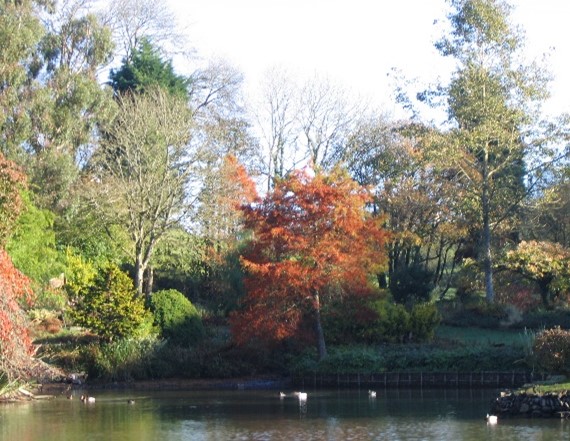
22
PLANT LADY!
Although
I said I was not going to sell plants this year, I had so many that I put them
out for a few weeks. I was so pleased
to be able to take £250 in to the Children's Hospice at Fremington, where I am
known as the Plant Lady!
As the
Hospice is celebrating its 25th Anniversary, they have been selling butterflies
[like the poppies at the Tower] which are to remain in their garden until
October, when they will be posted to their owners. They cost £15 each and are lovely, so I
treated myself and in so doing helped the Hospice which I know does such
wonderful work.
Thank you
yet again to the many villagers and holiday makers for buying plants. Although my donation was so much smaller
this year, it is such a pleasure to know that it is a help, even in a small
way, and is appreciated so much.
Thank you.
Margaret [Walls]
PS One of
the dads who has been helped by the Hospice said:
"Spending time at the hospice gives us the ability to
be a parent. Our daily life is consumed
with suctioning, medications, catheterising, repositioning, worry that our
child will not come out of the next big seizure. The time we spend at the hospice enabled us
to be family and a mummy and daddy to all three of our children. We are able to have fun as a family all in
the comforting knowledge that our child is receiving the best possible care."
23
IMPORTANT NOTICE!
BUTTERFLIES
These beautiful butterflies will only be available until the end of September, that is just two days following the circulation of this Newsletter. So, help the Hospice and
Order yours today!
Your butterfly will become part of this display in the garden of your local Children's Hospice South West until the end of September 2016. All butterflies will be posted during October 2016, in a beautiful commemorative box with a very special keepsake certificate. Each butterfly costs just £15 including postage and packaging.
Go to www.chsw.org.uk/25th-anniversary/butterfly and order now!

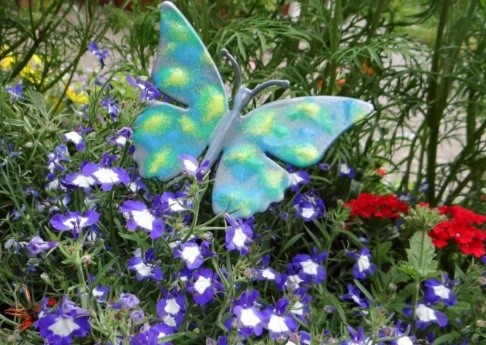
24
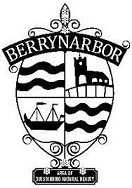
FROM THE PARISH COUNCIL
The Parish Council has had a busy year
dealing with various issues within the parish.
The Fountain at Sawmills has been repaired and the defunct Berry Down
phone box is now in place next to the shop.
A new Parish Council notice board will soon be going up on the wall of
the public lavatories next to the post box in the car park. The old notice board will also remain in use.
The new dog run area has garnered many thanks from dog owners in the village
and the new football nets and posts now mean that the village is a step closer
to the creation of a Berrynarbor Junior Football team. The existing scramble down short cut path
that had been causing considerable erosion to the bank for some years has been
made safe by the provision of a proper path but vehicle, pushchair and disabled
access is still by the usual existing route at the other end of the field. The replacement benches with backs should
provide a welcome place to rest while watching others be more active!
Looking to the rest of the year, the
Parish Council will be considering how it can improve and benefit the
community.
Councillors have spent the last few
months looking at the finances and gathering advice from various associations
that support and advise the parish Councils in their work.
Parish Councils are required to ensure
that its funds are used to
- provide community buildings
- support local community groups
- work with residents on local issues
- provide and support sports and recreation grounds
- promote and market the area for tourism
- provide and support entertainment and arts
- provide and maintain open spaces and biodiversity
- provide allotments if required
It is not good practice for a Parish
Council to keep large sums of money it its bank account for no reason, but it
must ensure that a reserve is kept for unforeseen circumstances and that
running costs can be met at all times.
The Council has accrued a substantial amount of money over the past
years and, while £10,000 has been earmarked for the refurbishment of the Manor
Hall and £5,000 has been agreed as the Council's minimum reserve level, it has
been noted that the Council should be using the monies saved for the benefit of
the Parish.
It is therefore important for the Parish
Council to identify areas that need improvement within the parish, to balance
the monies spent on all ages and sectors of the community and to ensure that
the work is carried out to a sufficient quality.
There are various grants and funds we
shall be accessing to help finance certain projects that we have on our 'wish
list' - these include a refurbishment of the lavatories, enhancement of the
Barton lane entrance to
the village, new village signs and planters [working in conjunction with Berry
in Bloom] and we welcome any suggestions from parishioners to add onto the
list. Some of these are priorities and
others are things we can, at present, only wish for!
The Parish Council is tentatively
looking at Neighbourhood Plans and if it decides to move forward with this project
a public meeting will be held with the village in due course. It involves a considerable amount of time
and work and the Council is discussing its merits at the moment. We shall keep you updated.
A lavatory refurbishment is part of our
long term plan, in the meantime a deep cleanse and a repaint will be carried
out shortly.
Tenders are invited for the internal
painting of the public lavatories. Apply to the Clerk Vicki_2@hotmail.co.uk
Sian
Barten - Vice-Chairman
Berrynarbor Parish Council
Adam Stanbury [Chairman] 882252
Jenny Beer [jen.beer@btinternet.com]
Julia Fairchild [882783]
Denny Reynolds [inskip828@btinternet.com]
Adrian Coppin [882647]
David Kennedy [07791 781283]
Clare White [882959]
Victoria Woodhouse - Parish Clerk - [vicki_2@hotmail.co.uk]
County Councillor - Andrea Davis [883865]
District Councillors - Yvette Gubb [882364], John Lovering [john.lovering@northdevon.gov.uk]
Snow Warden - Clive Richards [883406]
25
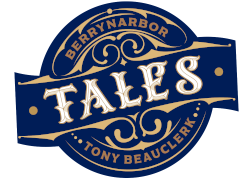
THE FIND
Jean and
Fred North were now retired and had just moved into a two- down three-up
semi-detached house in Llandrewdrig just north of Aberystwyth in Wales.
The house was in good decorative order
and did not need painting inside or out.
The back garden had a nice lawn and beyond that a little vegetable
plot.
However, the one thing they had always
wanted was a fish pond.
"Well," said Fred, "Where do you think
I should dig the hole for our fish pond and what shape?" he asked.

"How about down near the bottom of the
lawn," Joan replied.
"OK, I'll start tomorrow," said Fred
and the next day made an early start.
He carefully removed the turf from an
area of about seven foot by four and put it on one side thinking he might use
it elsewhere.
"This is a heavy soil" he thought and
by lunch time had only gone down about a foot.
He resumed his dig in the afternoon and
shortly his neighbour, Mr.
Robinson, leant over the fence and said, "I'm your new neighbour, nice to meet
you." They chatted for a while and got
along well.
As he had not got his pond deep enough,
Fred resumed the next day.
"Phew!
It's hard work," Fred said to himself and he stopped for a rest and
mopped his brow. Later, skimming his
spade over the surface, he exclaimed "Hello, what's this?" as he gently scraped
away it turned out to be a bone.
"Oh, my goodness," he though, "It looks
like a human bone!"
He took a hand trowel and gradually he
revealed a complete skeleton. What on
earth was he to do? He ran indoors to
tell Jean who was aghast at what he told her.
After a good strong cup of tea and a
lot of pondering, they decided to tell the police. It was not long before they heard the
wailing of a police car and a sergeant and constable arrived.
After seeing the hole with the bones in
it, the police asked, "How long have you lived here?" Jean and Fred assured them that they had
only just moved in and knew nothing of what had been found.
"Never the less, we should like your
passport just to be on the safe side, though you are not suspects," the
sergeant remarked.
It was only a short time before the
police erected a tent around the hole and told Jean and Fred that the bones
would be removed for forensic tests. In
due course this was done.
A day or two later Mr. Robinson was
there to have a chat over the fence and Fred explained what had happened and
asked him if he had any ideas on the matter.
"Well, give me a while to think about
it," he said.
Some time later the police called and
suggested that they all sit down to hear what they had to say. The sergeant cleared his throat and started
to explain that the skeleton had now been examined by their department dealing
with such matters and in fact the bones were not those of a human but were, in
fact, those of an orangutan.
"So, there won't be any charges and
here are your passports back."
Fred and Jean gave sighs of relieve but
were told by the police that they were still interested in how the bones got
there. "We shall continue our
enquiries", the constable remarked.
The next day Fred was in the garden,
this time filling in the hole as he and Jean had decided in view of what had
happened that they didn't want a pond any more.
Once again Mr. Robinson popped up over
the fence for his usual chat. "Why not
ask the oldest man in the village? His
name is Mr. Clegg and he lived at No. 3 Church Street. He is very with it despite his age, so go on
there's nothing to lose."
So the next day Fred made off to No. 3
and was invited in.
"Ah!"
Clegg smiled, "I think I have the answer. There was a Mr.
Cranham who had a zoo near here many years ago. The zoo never really took off and eventually
went bust. However, Mr. Cranham was
very fond of an orangutan called James and after the zoo closed, he took James
back to his home, now yours, to keep in an enclosure for the rest of his
days. James must have died and from
what you have told me been buried in what is now your garden!
"Well I never," gasped Fred, "The
police will be interested to know this."
As Fred left, he could hear Clegg muttering, "And so will Mr.
Robinson, the old know it all!"
Illustrated by: Paul Swailes
Tony Beauclerk -
Stowmarket
26
Flu and You
Combe Coastal Practice
Please come to the surgery for your flu vaccination.
We offer this vaccination to the following groups:
- Patients aged 65 or over or
Patients aged who are under 65 with any of the following problems:
- Asthma or another chronic chest complaint.
- Heart problems
- Diabetes
- Kidney disease
- Liver Disease
- Neurological Disease
- A pregnant woman
- A carer
- If you suffer from a serious illness and have a reduced ability to fight infection
For patients who are at risk the best action is to have a flu vaccination every year, this year you may receive a personalised text message or telephone call promoting the service, just follow the instructions given in your message.
We are not sending out letters to all patients to save on costs and paper but please give us a call or book online for your vaccination.
You can either telephone the surgery, after 11.00 am [to avoid the busiest times] and ask our team for an appointment at one of our special flu clinics.
We have various dates and times for clinics - give the surgery a call and speak to our reception team to book now!
We shall also be holding clinics especially for children, ask our team about these dates.
If you are unable to leave your home for medical reasons we can arrange for a District Nurse to administer your flu vaccination at home.
Please ring the surgery numbers below to arrange your appointment.
Surgeries can be contacted by telephone on the following numbers
Ilfracombe: 01271 863119 or 01271 863840 - Combe Martin: 01271 882406 - Woolacombe: 01271 870276
27
WEST COUNTRY WALK - 158
A Walk Through History
I'd never been to Tolpuddle so when I
saw, in the local paper, that a coach was going from Barnstaple, it seemed an
ideal opportunity. The village, six miles east of
Dorchester, is of course famous for the Tolpuddle Martyrs, the six agricultural
workers who in 1834 were sentenced to seven years' transportation to Australia. In 1830, the farm workers' wage had
been nine shillings a week. This was
reduced to eight shillings and then in 1833 to seven.

William Lamb, 2nd Viscount Melbourne, painted by John Partridge
John Partridge, Public domain, via Wikimedia Commons
When in 1834 the men were threatened
with a further reduction to six shillings a week, they tried to negotiate with
their employers, under the leadership of George Loveless and with the vicar
acting as an intermediary. Promises were made but not kept so the
men formed a Friendly Society of Agricultural Labourers to further their cause.
A local magistrate sought guidance from
the Home Secretary, Lord Melbourne, and the six men were arrested and
imprisoned at Dorchester. At the
Assizes they were tried under the Mutiny Act of 1797, charged with
administering an illegal oath. But
their real offence was uniting to defend their livelihoods. The jury was made up of local farmers
and the sentence of seven years in the penal colonies of Australia provoked a
great outcry. There were protests and
demonstrations in their support and a petition with a quarter of a million
signatures. Eventually, the Tolpuddle Martyrs won
free pardons and returned home after serving less than half of their sentences.
I started my walk at the western end of
the village where in 1934, a hundred years after the notorious trial, a row of
six cottages was built in memory of the Martyrs. It is a long, attractive building in
the Arts and Crafts style with a series of gables along the front and between
them deep roofs with a dozen dormer windows.
It is set back from the main road by a green swath and incorporates a
museum.
Next I headed for St. John's church
where in the churchyard studded with self-heal and ladies' bedstraw, can be found
James Hammett's grave. He was the only
one of the six Martyrs to settle in Tolpuddle on his return from
transportation. In 1934 a headstone
carved by Eric Gill was added to the grave. In the centre of the village is a
three-hundred-year old sycamore known at The Martyrs' Tree, under which the men
gathered for some of their meetings.
Further along on the opposite side of
the road is Thomas Stanfield's cottage where the friendly society met - a neat
white cottage typical of the village.
His son John was also one of the six Martyrs. George Loveless and his brother James
[another Martyr] were both Methodist lay preachers and at the eastern end of
the village is the Methodist Chapel with its elaborate memorial arch. But before that, lies a much more
recent addition to the village. About
ten years ago, after an acre of land had been set aside for use as public open
space, a group of villagers under the acronym TOSCA [Tolpuddle Open Space]
created a picnic area, adventure playground, orchard and wild flower meadows.
Gatekeepers and small skipper
butterflies homed in on the field scabious, meadow cranesbills, knapweed and
ox-eye daisies. There are gnarled old
apple trees, red current and spindle bushes.
The restored village pump stands under a huge bay tree.
In 1630 sluices and weirs had been
constructed to manage water from the chalk springs and River Piddle and to
produce there these water meadows. And
now in the twenty-first century thanks to TOSCA's thoughtful landscaping they
provide a delightful feature.
Should you ever find yourself in this
part of Dorset, I would recommend a walk through this interesting village.

Illustatrated by: Paul Swailes
Sue H
28
MOVERS AND SHAKERS - NO. 65
MRS. KATHERINE WALLACE
[Late 1600's - early 1700's]
Chambercombe Manor
[Otherwise Kate Oatway]
It
was a pleasant, sunny day [yes, we had one or two this summer!] when we decided
to take a visitor to Chambercombe Manor. It was some years since our last visit, yet
the Manor had lost none of its charm.
In parts dating back to the 11th century
- it is mentioned in the Domesday Book - this dwelling is reputed to be the
most haunted house in the United Kingdom!
A host of phenomena have been
noted over the years: the swinging pendulum of a clock without its weights,
spinning of curtain poles, unexplained rocking of a baby's crib, and many other
things.

The Champernon family owned it from
around 1160 until the early 16th century when Henry, Duke of Suffolk and father
of Lady Jane Grey, became the owner. There
passed many years during which it lost its prowess as a Manor House and became
a farm - and here begins the story of Kate Oatway.
"It was a warm sunny afternoon in the
'sixties of the last century . . . even the fowls were quiet and the farm dogs
lay basking in the sun" starts the official guide book's opening of
the legend of The Haunted Room - later detailed as 1865 - that tells the story
of a mysterious discovery.
On that day the tenant farmer, Jan, was
carrying out repairs to the thatched roof when he noticed for the first time
the outline of a window to a room he didn't know about. Mystified, he searched inside the house and
realised that there must be a secret room between what is now called 'Lady Jane
Grey's' room and the next room. He and his wife managed to break through the
wall. The air was musty, but lighting a
candle they could see in the dimly lit chamber, the remains of a magnificent
tapestry on the walls, ashes from a wood fire in the grate and in the centre a
four-poster bed made of black oak and enveloped in dusty curtains. Somewhat hesitatingly, they pulled these aside
to find laid out on the bedspread and yellow with age, a skeleton, its bony
fingers clutching the coverlet!
It was sometime before the authorities
decided that the skeleton was that of a young woman, but who she was and how
she died was not discovered. However,
rumour had it that the ghost who subsequently haunted Chambercombe Manor was
that of Kate Oatway, whose father William Oatway, took tenancy of the Manor in
1695. Her grandfather, Alexander, was a rich
landowner who was a notorious wrecker of ships. He would go out at night with a
band of villains waving lanterns from the shore in the hopes of luring ships
onto this treacherous coastline. They
would then murder the crew and any passengers, and plunder the wreck. The booty
could then be taken through the secret smugglers passage from Hele Beach back
to the Manor.
William, however, was much more law
abiding. He married a beautiful Spanish
lady whom he had saved from one of his father's wrecking expeditions. He would have loved to buy Chambercombe
Manor, but didn't have the money, so leased the property. In time, they produced a daughter whom they
christened Katherine, who inherited her mother's good looks and grew into a
vivacious young woman.
Kate met and fell for an Irishman,
Captain Wallace, and after their marriage they decided to live in Dublin. A tearful Kate said goodbye to her parents,
vowing to return one day to visit them.
One night, sometime later, during a
ferocious storm, William went down to the beach to help out with a wrecked
ship. Suddenly, during a lull in the
howling gale, he heard a moan from nearby rocks and discovered a young woman,
badly beaten and bloodied from being dashed against the rocks. He carried her back to the Manor where he and
his wife did their best to save her, but her injuries were so many that she
died that night. They searched her body
hoping to find out her identity and came
upon a money purse strapped around her waist. On opening it, there was so much gold and
jewellery that with shaking hands, William realised that he could buy his
beloved manor - and so took the purse off the body.
Next day, a shipping agent called at the
Manor, asking if they had seen a lady passenger missing from the ship. William, scared that he would be robbed of
his new wealth if he said anything, denied having seen her. He was then asked to keep an eye on the
coastline in case the body, that of a
lady called Mrs Katherine Wallace, should be washed up.
William
was horrified. He had robbed his own
daughter! He promptly walled up her
body in what was to become the secret chamber and he and his wife left
Chambercombe Manor, never to return.

And so, if you visit Chambercombe Manor
on a dull day, and hear ghostly footsteps along the corridors, or hear a low
moaning from the secret chamber, or pass through a cold spot within the house,
don't be alarmed,
they may have nothing to do with Kate! There
have also been sightings of two little girls in an upstairs window, a ghostly
figure dressed in white by the pond outside the cafe, and a friendly male ghost
who tries to proposition the ladies.
But it's a shame to spoil a good legend!
By the way, you still have time to go to
Chambercombe this year until October 28th. I'd recommend you take a guided tour
[Tuesdays, Wednesdays and Thursdays] as it's worth the extra £4. You are allowed to take photographs inside
the house and who knows what you may find on your camera?
PP
of DC
29

30
AT-A-GLANCE DIARY
| OCTOBER | |
| 2nd | St Peter's Church: 11.00 a.m. Harvest Festival |
|---|---|
| 5th | St. Peter's Church: Harvest Supper, Manor Hall, 6.30 p.m. |
| 9th | St. Peter's Church: 11.00 a.m. Holy Communion |
| 11th | Parish Council Meeting, Manor Hall, 7.00 p.m. |
| 16th | St. Peter's Church: 11.00 a.m. Songs of Praise |
| 17th | to 28th: Primary School - Half Term |
| 19th | Wine Circle, 8.00 p.m., Manor Hall - Bray Valley Wines |
| 23rd | St. Peter's Church: 11.00 a.m. Installation of Michael Rogers |
| 24th | to 28th inc. Ilfracombe Academy - Half Term |
| 25th | Mobile Library in Village from 11.40 a.m. to Friday 28th: Craft and Art Display, Manor Hall, daily 10.00 a.m.to 12.30 p.m. and 2.00 to 4.30 p.m. |
| 28th | Craft and Art Display, Manor Hall, 7.00 to 9.00 p.m. |
| 29th | Craft and Art Display, Manor Hall, 10.00 a.m. to 12.30 p.m. |
| 30th | Summer Time Ends - Clocks go back one hour at 1.00 a.m. St. Peter's Church: 11.00 a.m. Joint Service with Combe Martin. |
| NOVEMBER | |
| 4th | St. Peter's Church: Military Wives Choir, 7.30 p.m. |
| 8th | Parish Council Meeting, Manor Hall, 7.00 p.m. |
| 11th | Soup & Pudding Evening, Kentisbury Village Hall, 7.00 p.m. |
| 13th | St. Peter's Church: Remembrance Sunday, 10.45 a.m. |
| 16th | Wine Circle, 8.00 p.m. Manor Hall |
| 22nd | Mobile Library in Village from 11.40 a.m. |
| Manor Hall Diary | |
| Mondays | Upholstery, 9.00 to 1.00 p.m.Craft Group, 1.45 p.m. Badminton, 7.30 p.m. |
|---|---|
| Tuesdays | N.D. Spinners [2nd & 4th] 3rd: Craft Art Group, 9.30 a.m. |
| Wednesdays | Pilates Body Workout, 9.00 a.m. School p.m. |
| Thursdays | Watercolour Painting 10.00 a.m. [10 week terms] |
| Fridays | Toddlers Soft Play and Activity a.m. Primary School p.m. |
| Penn Curzon Room | Pre-School: Daily - Term time only Breakfast Club ages 2-11, Daily 8.00-9.00 a.m. Morning Session: 8.30 - 12.00 or 1.00 p.m. Afternoon Session: 12.00 to 3.00 or 4.00 p.m. All Day: 8.30 a.m. to 4.00 p.m. |
| Mobile Library | |
| Village Shop: 11.40-12.10 p.m. Sterridge Valley: 12.25-12.55 p.m. | |
School, Pre-School and Toddler Group - Term Time only
31
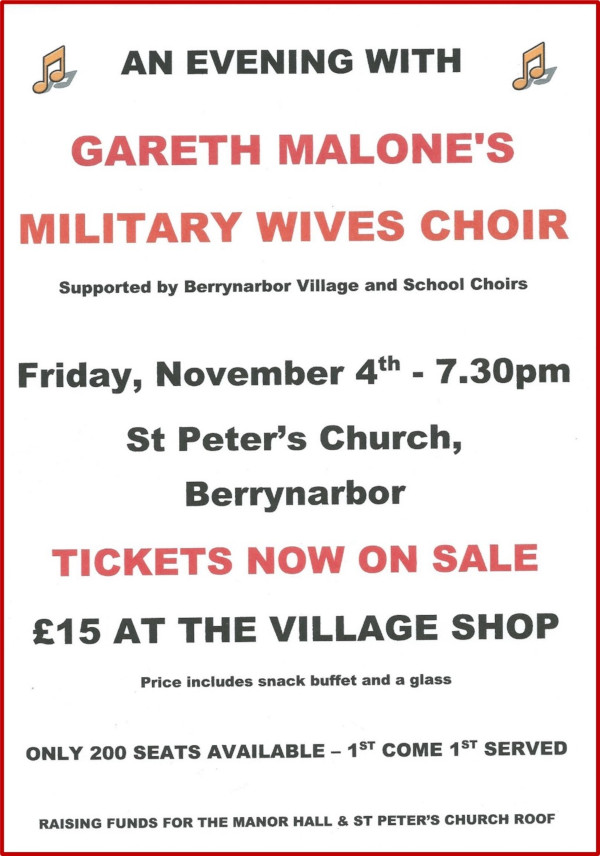
32
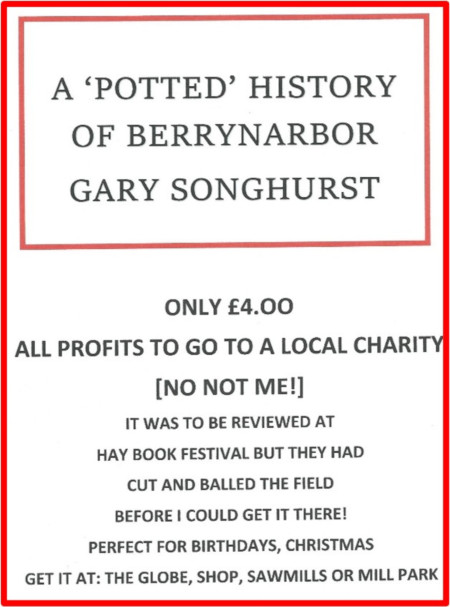
33
CHRISTMAS GREETINGS THROUGH THE
NEWSLETTER
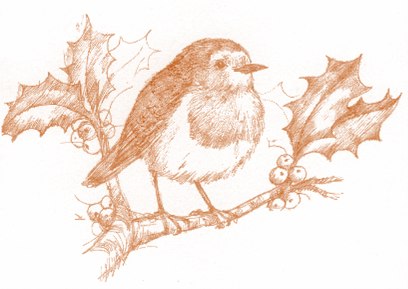
Although
it may seem rather early to be thinking about Christmas, cards are already on
sale but fortunately no advertising on the television as yet! However, it won't be too long!
Sending
your seasonal greetings to friends and neighbours here in the village through
the Newsletter has become both traditional and popular, and you will be able to
do so again this year.
To
everyone, especially newcomers, if you would like to do this, it is very
simple. Just decide on your message and
leave it, with a donation, either at Chicane or the Shop and by Wednesday, 9th
November at the latest, please.
After
covering the costs of printing, donations will be shared between the Newsletter
and the much needed funds for the Manor Hall.
Donations have always been very generous, so please carry on with that
tradition as well!
34
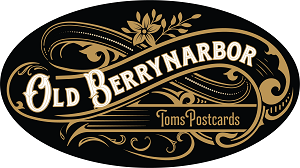
OLD BERRYNARBOR - VIEW NO. 63
Berrynarbor Church and Village
For
this month I have chosen an upright view of St. Peter's Church and part of the
village.
This
view was taken by Thirken Photographer Berrynarbor around 1920. What I find very interesting is the fact
that a door can be seen to the left of the Penn-Curzron Room as well as a door
shown on the right. I wonder if the
door on the right gave entrance only to the stair to the first floor room which
we know as the Men's Institute Room [Snooker].
The
roof of Tower Cottage can be seen, complete with its tall chimney, just below
the church tower. A
small group of people, including children, can just be seen standing at the
bottom of the church steps, outside the bus shelter.
In
the centre the roof of what was Claude Richards cottage and dairy [now
Dunchideock] can just be seen, together with the three cottages just to the
right. In the foreground is the roof of
Briar Cottage, at one time our post office.
Tom
Bartlett
Tower Cottage, September 2016
e-mail: tomandinge40@gmail.com
CROSSWORD ANSWERS


